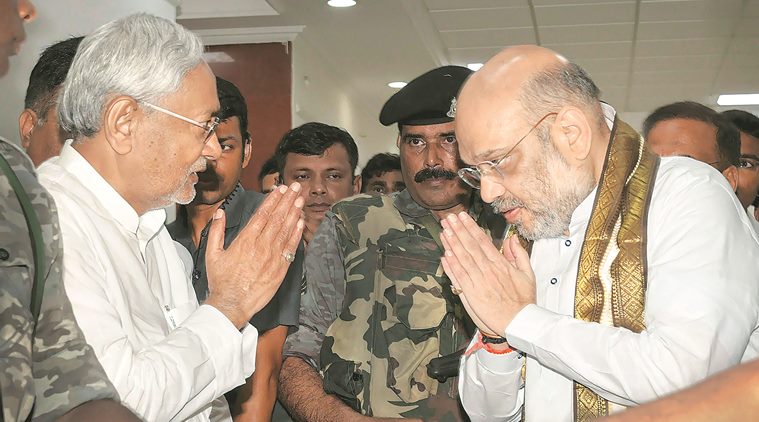Elections in Bihar over the last 2½ decades may have been between two or among three sides — depending on alignments among BJP, JD(U), RJD and Congress — but the smaller parties too have had a say since 2000, and particularly during the 2014 Lok Sabha elections.

Ram Vilas Paswan’s LJP is among the oldest of the smaller parties. It identifies primarily with Paswans, who number about 5% among Bihar’s 16% SC population, and has consistently polled in the range of 5.5-8%. It grew in relevance after winning 29 Assembly seats in February 2005, before being reduced to 9 Assembly seats in October 2005. After returning to the NDA in 2014, the LJP won six of seven Lok Sabha seats contested, its best yet. In the 2015 Assembly polls, it managed just two seats as its vote share dropped from 6.4% to 4.8%.
For 2019, the BJP has given the LJP five seats in Bihar and one in UP and offered Paswan a Rajya Sabha berth. He will look to bring to the NDA votes of Paswans and other SC groups including Pasis, while the BJP-JD(U) between them target the votes of non-Yadav OBCs, EBCs, upper castes, and sections of the Mahadalit group of 21 SCs. Paswan’s open support to the EWS quota can also win him upper-caste support, especially when the RJD has opposed it. LJP holds influence in Hajipur, Vaishali, Khagaria, Samastipur, Munger and Jamui, and will have some say in all major seats with a sizeable Paswan population.

Rashtriya Lok Samata Party
The RLSP, formed by Upendra Kushwaha in 2013, fought its first election in 2014 under the NDA banner. Kushwaha, a former Union minister, is an OBC Koeri leader from Vaishali and was once a protégé of Chief Minister Nitish Kumar. Kushwaha and Nitish identify with almost the same social group of OBC Koeris-Kurmis, who make about about 10% of the state population. With the Kushwahas dominant at about 7%, Upendra followed ambitions of becoming a major OBC leader; he joined the NCP at one stage, then returned to JD(U) before eventually forming the RLSP. In 2014, Kushwaha turned down an offer from the RJD and chose to join the NDA, which paid off. In its very first election, the RLSP won all its three seats including Karakat by Kushwaha himself. But in 2015, it could win only two of 23 Assembly seats contested with a 2.6% vote share. When Kushwaha quit the NDA, the BJP did not try to stop him; Nitish had returned to the fold and addressed the same communities.
In 2019, Kushwaha will be important for the RJD-Congress, which are looking for 8-10% votes more than in 2014. Then, RJD, Congress and NCP had managed a little under 30% against the NDA’s nearly 39%. The RJD is banking on Upendra making a dent into Nitish’s vote-base.
Hindustani Awam Morcha (S)
The HAM(S) was formed in 2015 by former CM Jitan Ram Manjhi, who rebelled against Nitish Kumar after being removed from power and the JD(U). It contested the 2015 Assembly polls as part of the NDA. Manjhi represents the Mushahar community. Before Nitish made him CM, he had been SC/ ST Welfare Minister and kept a low profile; during his nine months in the chair, he tried to emerge a major SC leader. In 2015, his party contested 23 seats, polled 2.3% and won just one seat – Manjhi himself, who lost his existing seat but won against outgoing Assembly Speaker Uday Narayan Choudhary of the JD(U). Manjhi is now an ally of the RJD. His influence is believed to be partially responsible for the RJD winning bypolls in Araria (Lok Sabha), Jehanabad and Jokihat (Assembly).
For 2019, Manjhi has been talking about at least two seats, and has been claiming he has a following bigger than Congress, but the RJD feels his influence is limited to the Magadh belt of Gaya and Jehanabad. Manjhi is in talks with the NDA too. He does add value to any combination but leads essentially a one-man party, with many leaders having left.
Vikasshil Insaan Party
Story continues below this ad
The VIP is a new party formed by Mukesh Sahni, an EBC Mallah (boatman) leader from North Bihar who pitches himself as “Son of Mallah”. Over the last five years, he has organised successful rallies of EBC Nishad, Mallah and Sahni communities (about 8% of the state population). Although yet to face a political test, he appears to enjoy some influence among these caste groups. EBC votes are always an important consolidating factor for any alliance. RJD leader Tejashwi Prasad Yadav has brought Sahni into the Grand Alliance fold and he has been reportedly offered two seats. Its influence areas could be Muzaffarpur, Darbhanga, Jhanjharpur, East Champaran and Valmiki Nagar. But with BJP MP Kirti Azad having joined the Congress, he would expect to recontest from Darbhanga; it remains to be seen if Sahni too is eyeing it.
Loktantrik Janata Dal
The LJD is the party floated by breakaway JD(U) MP Sharad Yadav. It does not have a functioning cadre and is banking on the RJD network. It has former Rajya Sabha MP Ali Anwar and former Assembly Speaker Uday Narayan Choudhary in its ranks, but is seen as a one-man party. While seen as restricted to Sharad Yadav’s own Madhepura, the LJD has been demanding at least two seats. For the alliance, it is more about showcasing a leader of national stature than about gaining from a small party.

 Bihar Chief minister Nitish Kumar with BJP president Amit Shah. (PTI/File)
Bihar Chief minister Nitish Kumar with BJP president Amit Shah. (PTI/File)






































